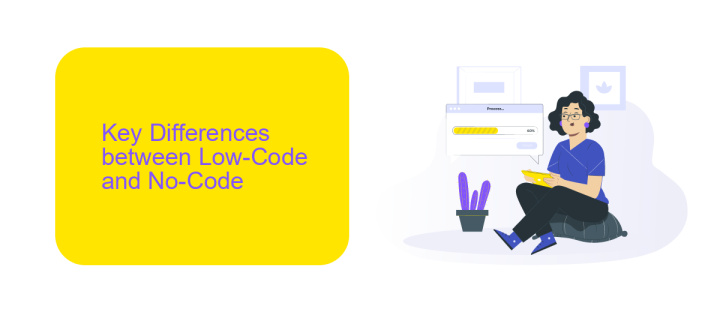Difference Between Low-Code and No-Code
In today's fast-paced digital landscape, the demand for rapid application development has given rise to low-code and no-code platforms. These innovative solutions empower users to create applications with minimal coding knowledge. However, understanding the key differences between low-code and no-code is essential for choosing the right approach to meet your organization's specific needs and goals.
Understanding Low-Code and No-Code
Low-code and no-code platforms have revolutionized the way applications are developed by enabling users to create software with minimal or no coding knowledge. These platforms provide visual interfaces and pre-built templates, making it easier for non-developers to build and deploy applications quickly.
- Low-Code: Requires some level of coding knowledge. It allows developers to customize applications beyond the pre-built templates.
- No-Code: Designed for users with no coding experience. It offers drag-and-drop features to build applications entirely through a visual interface.
Both low-code and no-code platforms are beneficial for rapid application development and can be integrated with various services to enhance functionality. For instance, ApiX-Drive is a powerful integration service that allows users to connect different applications and automate workflows without needing to write complex code. This makes it easier to manage data and processes across multiple platforms, further streamlining operations and increasing efficiency.
Key Differences between Low-Code and No-Code

Low-code and no-code platforms cater to different user needs and technical expertise. Low-code platforms are designed for developers who need to build applications quickly with minimal hand-coding. These platforms offer more flexibility and customization options, allowing developers to write custom code when necessary. In contrast, no-code platforms are aimed at business users or "citizen developers" with little to no programming skills. They provide pre-built templates and drag-and-drop interfaces, enabling users to create applications without writing any code.
Another key difference is the level of complexity and scalability. Low-code platforms are typically more suited for complex, large-scale enterprise applications that may require integration with existing systems and databases. For instance, ApiX-Drive can be used to effortlessly set up integrations between various services, enhancing the functionality of low-code applications. No-code platforms, on the other hand, are ideal for simpler, smaller-scale applications that address specific business needs without requiring extensive customization or integration capabilities.
Benefits of Low-Code over No-Code

Low-code platforms offer several advantages over no-code solutions, particularly for businesses with more complex requirements and the need for greater customization. One significant benefit is the ability to write custom code, which allows for more advanced functionality and flexibility in application development.
- Enhanced Customization: Low-code platforms allow developers to insert custom code, providing the flexibility to create more tailored and sophisticated applications.
- Better Integration: With low-code, it's easier to integrate with existing systems and third-party services like ApiX-Drive, which simplifies the process of connecting different software solutions.
- Scalability: Low-code solutions are generally more scalable, making them suitable for larger projects that may grow in complexity over time.
- Developer Control: Low-code platforms offer more control to developers, enabling them to optimize performance and security aspects of the application.
In summary, low-code platforms bridge the gap between no-code simplicity and full-code flexibility, making them ideal for businesses seeking a balance of ease of use and advanced customization. This approach empowers developers to create more robust and scalable applications while maintaining the ability to integrate seamlessly with other services and systems.
Benefits of No-Code over Low-Code

No-code platforms offer distinct advantages over low-code solutions, particularly for users without technical backgrounds. These platforms are designed to be highly intuitive, enabling non-developers to create applications through simple drag-and-drop interfaces. This ease of use can significantly reduce the time and cost associated with application development.
One of the major benefits of no-code platforms is their ability to streamline the integration process. For example, services like ApiX-Drive facilitate seamless integrations between various applications without requiring any coding skills. This allows businesses to automate workflows and enhance productivity effortlessly.
- Reduced development time and costs
- Increased accessibility for non-technical users
- Enhanced ability to quickly adapt to market changes
- Streamlined integration processes with tools like ApiX-Drive
Ultimately, no-code platforms democratize the development process, making it accessible to a broader audience. This inclusivity not only accelerates innovation but also empowers teams to take control of their digital transformation initiatives without relying heavily on IT departments.
Choosing the Right Option for Your Needs
When deciding between low-code and no-code platforms, it's essential to evaluate your specific needs and technical expertise. Low-code platforms are ideal for businesses with some coding knowledge or a dedicated IT team, as they offer greater flexibility and customization options. These platforms allow for the development of more complex applications and can integrate with existing systems more seamlessly. On the other hand, no-code platforms are designed for users with little to no programming experience, enabling them to create functional applications quickly and efficiently. They are perfect for small businesses or departments looking to solve specific problems without relying on IT resources.
Consider the scale and complexity of the projects you aim to undertake. If your applications require intricate workflows or custom integrations, a low-code solution might be more appropriate. For instance, using a service like ApiX-Drive can facilitate the integration of various applications and automate workflows, enhancing the capabilities of your low-code platform. Conversely, if your needs are more straightforward and you prioritize speed and ease of use, a no-code platform could be the right choice. Ultimately, the decision should align with your business goals, technical capacity, and the specific requirements of your projects.
FAQ
What is the main difference between low-code and no-code platforms?
Who typically uses low-code platforms?
Can no-code platforms handle complex business processes?
Are low-code and no-code platforms secure?
How can I integrate different applications using low-code or no-code platforms?
Time is the most valuable resource in today's business realities. By eliminating the routine from work processes, you will get more opportunities to implement the most daring plans and ideas. Choose – you can continue to waste time, money and nerves on inefficient solutions, or you can use ApiX-Drive, automating work processes and achieving results with minimal investment of money, effort and human resources.

